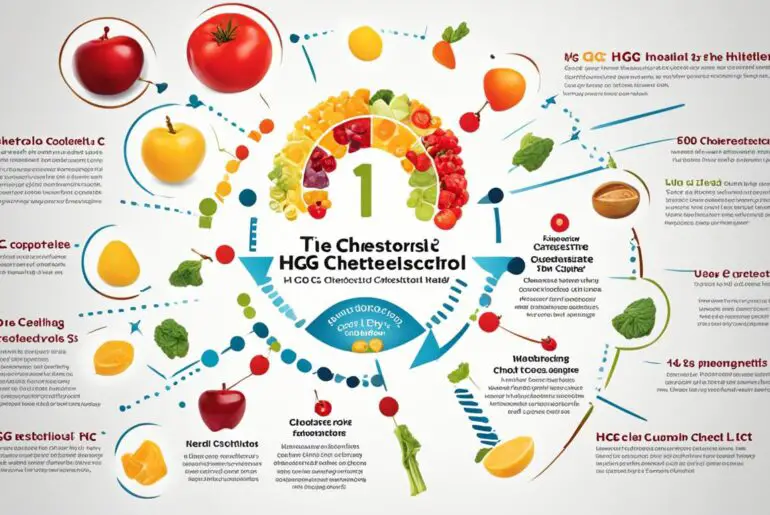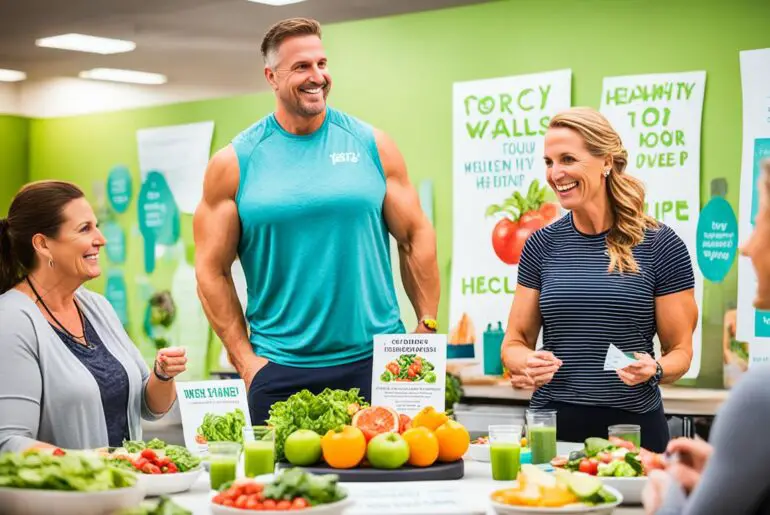Are you tired of trying various diets without seeing the desired results? Have you heard about the HCG diet plan but are unsure if it’s right for you? Whether you’re a beginner looking to kickstart your weight loss or simply curious about this popular weight loss protocol, this comprehensive guide has got you covered. Get ready to discover the ins and outs of the HCG diet plan, from the basics to the phases, meal plan, tips, recipes, and even the expected results. But first, let’s delve into what exactly the HCG diet is and how it works.
Key Takeaways:
- Learn about the HCG diet plan, a weight loss protocol developed by Dr. Albert Simeons in 1954.
- Explore the different phases of the HCG diet, including the loading phase, weight loss phase, and maintenance phase.
- Discover approved foods and portion sizes for the HCG diet meal plan.
- Gain insights into tips for success and common mistakes to avoid on the HCG diet.
- Understand the potential results and effectiveness of the HCG diet for beginners.
Understanding the HCG Hormone
The HCG (Human Chorionic Gonadotropin) hormone is a naturally occurring hormone produced in large amounts during early pregnancy. Its primary function is to support the healthy growth of the uterus and fetus by maintaining the production of important pregnancy hormones.
In the context of the HCG diet, this hormone is believed to play a role in weight loss. It is thought to alter metabolism and promote the use of abnormal fat reserves for energy, leading to enhanced weight loss results. However, it is important to note that scientific evidence does not support the effectiveness of the HCG hormone in weight loss.
The primary driver of weight loss on the HCG diet is the low-calorie intake, which restricts energy consumption. By consuming only 500 calories per day during the weight loss phase, individuals create a calorie deficit that ultimately leads to weight loss.
While the HCG hormone may have other functions and implications in the body, its role in weight loss on the HCG diet remains an area of controversy and ongoing research.
“The HCG hormone is believed to alter metabolism and promote the use of abnormal fat reserves for energy, leading to enhanced weight loss results.”
It is important to consult with a healthcare professional before starting the HCG diet or any weight loss program to ensure it is safe and suitable for your individual needs. They can provide personalized guidance and advice based on your specific health status and goals.
| Function of HCG in the body | Role of HCG in weight loss |
|---|---|
| Supports healthy growth of the uterus and fetus during pregnancy | Believed to alter metabolism and promote the use of abnormal fat reserves for energy |
| Stimulates the production of important pregnancy hormones | Controversial and lacking scientific evidence for its effectiveness in weight loss |
| Weight loss achieved on the HCG diet is primarily due to the low-calorie intake |
The Phases of the HCG Diet

The HCG diet consists of several phases that are designed to maximize weight loss and support long-term success. Understanding these phases is crucial for following the diet effectively and achieving your desired results. The HCG diet phases include the loading phase, weight loss phase, and maintenance phase.
1. Loading Phase
The loading phase is the initial phase of the HCG diet. During this phase, you consume high-fat foods for 2 days while taking the HCG hormone. The purpose of the loading phase is to build up your fat reserves and prepare your body for the low-calorie phase that follows. This phase helps alleviate hunger and ensures your body has enough energy to sustain you during the weight loss phase.
2. Weight Loss Phase
The weight loss phase is the core phase of the HCG diet. It typically lasts for 3 to 6 weeks, depending on your specific weight loss goals. During this phase, you consume only 500 calories per day while continuing to take the HCG hormone. The combination of calorie restriction and HCG hormone is believed to promote fat burning and facilitate rapid weight loss.
3. Maintenance Phase
The maintenance phase is the final phase of the HCG diet. After completing the weight loss phase, you gradually increase your food intake and transition to a higher-calorie diet. However, you still need to avoid sugar and starch during this phase to prevent weight regain. The maintenance phase is crucial for stabilizing your weight loss and maintaining a lower body weight in the long-term.
The HCG diet phases play a vital role in guiding your journey towards weight loss and sustainable results. Each phase serves a specific purpose and contributes to your overall success on the diet. By understanding and following these phases diligently, you can optimize your weight loss efforts and achieve your desired goals.
| Phase | Description |
|---|---|
| Loading Phase | Consume high-fat foods for 2 days while taking HCG hormone |
| Weight Loss Phase | Follow a 500-calorie per day diet while continuing HCG hormone |
| Maintenance Phase | Gradually increase food intake while avoiding sugar and starch |
HCG Diet Meal Plan
When following the HCG diet, it’s important to have a precise meal plan that includes approved foods and portion sizes. The diet is divided into phases, with the weight loss phase being the most critical. During this phase, a typical meal on the HCG diet consists of the following:
- A serving of lean protein, such as veal, beef, chicken breast, or fish
- A serving of vegetables
- A serving of bread
- A serving of fruit
It is crucial to strictly adhere to the approved foods list and avoid butter, oils, and sugar. Drinking plenty of water is essential for staying hydrated and supporting your weight loss journey on the HCG diet.
Since the HCG diet restricts calorie intake to around 500 calories per day, it is highly recommended to consult with a healthcare professional before starting the HCG diet to ensure it aligns with your specific needs and goals.
Remember, a well-planned HCG diet meal plan with the right foods and portion sizes is key to achieving success on your weight loss journey.
| Food Group | Approved Foods |
|---|---|
| Proteins | Veal, beef, chicken breast, fish |
| Vegetables | Spinach, lettuce, cucumbers, cabbage, tomatoes |
| Bread | Melba toast, grissini breadsticks |
| Fruits | Apples, oranges, strawberries, grapefruit |
HCG Diet Tips for Beginners
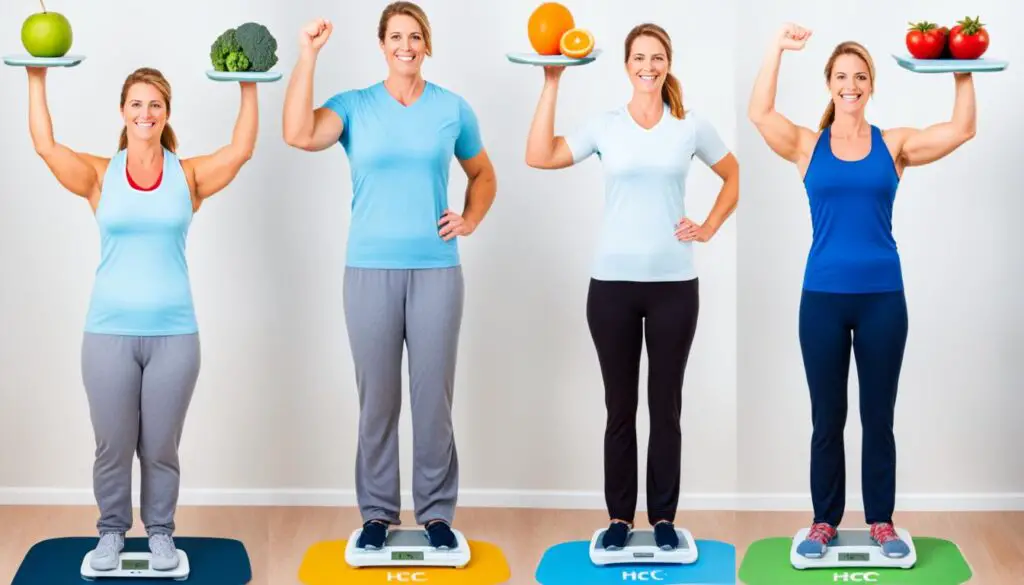
The HCG diet can be challenging, especially for beginners. However, with the right strategies and mindset, you can set yourself up for success. Here are some HCG diet tips to help you navigate through the program and avoid common mistakes:
- Consult with a healthcare professional before starting the diet: It’s essential to seek medical advice before embarking on any diet or weight loss program. A healthcare professional can assess your health status, provide personalized guidance, and ensure the HCG diet is safe for you.
- Plan your meals and make sure you have approved foods on hand: Planning your meals in advance can help you stay on track and avoid making impulsive food choices. Stock up on HCG diet-approved foods, such as lean proteins, vegetables, fruits, and bread options.
- Stay hydrated by drinking plenty of water: Drinking an adequate amount of water is crucial for overall health and can help prevent dehydration while on the HCG diet. Aim to drink at least 8 cups (64 ounces) of water per day.
- Avoid temptation by removing non-HCG items from your sight: Out of sight, out of mind. Clear your pantry and refrigerator of non-HCG foods to reduce temptation and make sticking to the diet easier.
- Avoid excessive exercise while on the diet: The HCG diet is a low-calorie program, and engaging in intense exercise can put additional strain on your body. Focus on light to moderate physical activity, such as walking or gentle yoga, for overall well-being.
- Follow the diet strictly and avoid cheating: The success of the HCG diet relies on strict adherence to the protocol. Avoid cheating or deviating from the recommended foods and portion sizes to maximize your chances of achieving your weight loss goals.
- Keep track of your progress by weighing yourself regularly: Monitoring your progress can help you stay motivated and gauge the effectiveness of the HCG diet for you. Weigh yourself consistently, preferably at the same time of day, and keep a record of your weight.
- Seek support from a healthcare professional or a support group: Having support can make a significant difference in your HCG diet journey. Lean on your healthcare professional for guidance and consider joining an HCG diet support group for encouragement and accountability.
- Be prepared for potential side effects and consult with a healthcare professional if needed: Like any diet, the HCG diet may have side effects. Be aware of potential symptoms such as fatigue, headaches, or dizziness. If you experience any concerning side effects, consult with a healthcare professional for evaluation and guidance.
By implementing these HCG diet tips for beginners, you’ll be well-equipped to navigate the challenges and maximize your chances of achieving success on the HCG diet.
HCG Diet Phase 1 for Beginners
Phase 1 of the HCG diet is known as the loading phase. During this phase, you consume high-fat foods for 2 days while taking the HCG hormone. The purpose of this phase is to replenish normal fat reserves and prevent hunger at the start of the low-calorie phase. It is important to follow the guidelines and consume foods that are high in fat but not restricted in the subsequent phases. This phase can be challenging but is crucial for the success of the HCG diet.
In the loading phase, you will be consuming calorie-dense foods to build up your body’s fat reserves. This phase allows your body to adjust and prepare for the calorie restriction in the following phase. It is necessary to consume foods that are high in fat to ensure an adequate supply of energy during the low-calorie phase.
During the loading phase, you can enjoy foods such as:
| Foods | Examples |
|---|---|
| Meats | Bacon, sausage, fatty cuts of beef or pork |
| Dairy Products | Cheese, butter, whole milk |
| Oils and Fats | Olive oil, coconut oil, mayonnaise |
| Nuts and Seeds | Almonds, walnuts, sesame seeds |
| Sweets and Snacks | Chocolate, ice cream, chips |
Remember:
- Stick to foods that are high in fat to fulfill the purpose of the loading phase.
- Do not restrict your calorie intake during this phase; instead, focus on calorie loading to build up fat reserves.
- Avoid sugary and starchy foods as they are not recommended.
- Continue taking the prescribed amount of the HCG hormone during this phase.
- Consult with a healthcare professional for personalized guidance and support during the HCG diet.
By following the loading phase of the HCG diet, you are setting the stage for successful weight loss during the subsequent phases. It is important to stay committed and adhere to the guidelines provided by your healthcare professional to maximize the effectiveness of the HCG diet.
HCG Diet Phase 2 for Beginners
Welcome to Phase 2 of the HCG diet, also known as the weight loss phase. This is where the magic happens and you start seeing significant changes in your body composition and overall weight. During this phase, you will be following a strict calorie restriction of only 500 calories per day while continuing to take the HCG hormone.
The goal of Phase 2 is to promote fat burning and achieve your weight loss goals. By following the approved foods and portion sizes, you’ll be providing your body with the necessary nutrients while still creating a calorie deficit that leads to weight loss. It’s important to note that the HCG hormone is believed to enhance the effects of calorie restriction, making this phase even more effective.
During Phase 2, you’ll want to focus on lean proteins, such as chicken breast, fish, or lean cuts of beef, as well as plenty of vegetables. These foods will help keep you satisfied while providing your body with the necessary nutrients. Additionally, be sure to follow the approved portion sizes to ensure you’re not exceeding the 500 calorie limit.
Monitoring your progress and consulting with a healthcare professional is essential during this phase. Regular check-ins will help ensure that you’re on track and making progress towards your goals. If you experience any concerns or have questions, don’t hesitate to reach out to your healthcare professional for guidance.
Remember, Phase 2 is a crucial part of the HCG diet, where you’ll experience significant changes in your weight and body composition. Stay committed, follow the guidelines, and monitor your progress closely. The results will be well worth the effort.
Phase 2 Highlights:
- Strict calorie restriction of 500 calories per day
- Continue taking the HCG hormone
- Focus on lean proteins and vegetables
- Follow approved portion sizes
- Regularly monitor progress and consult with a healthcare professional
| Approved Foods | Portion Sizes |
|---|---|
| Chicken breast | 100g |
| White fish | 100g |
| Lean beef | 100g |
| Shrimp | 100g |
| Asparagus | 1 cup |
| Spinach | 2 cups |
| Apple | 1 medium |
| Strawberries | 1 cup |
| Melba toast | 1 piece |
HCG Diet Phase 3 for Beginners
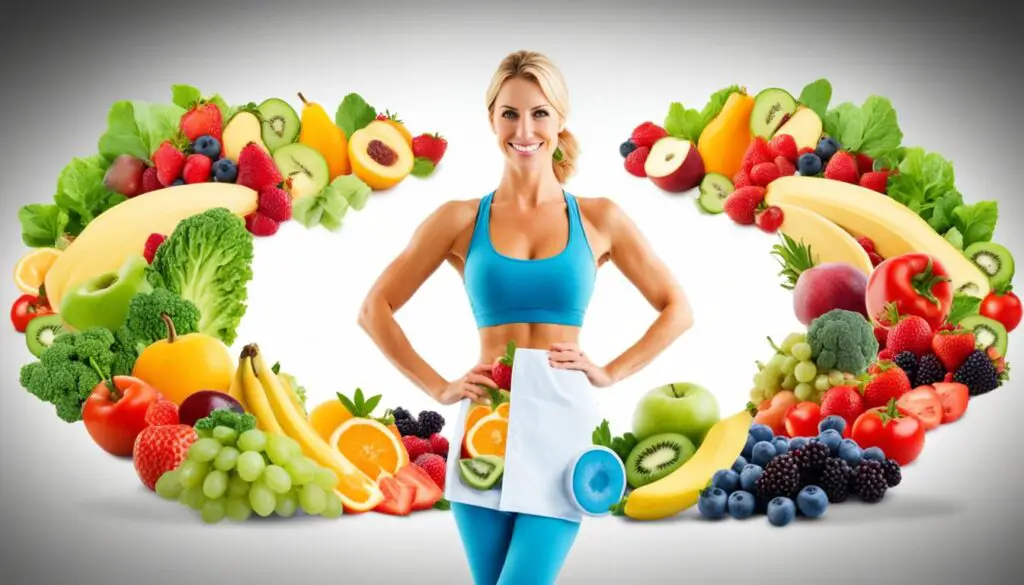
Once you have successfully completed the weight loss phase of the HCG diet, it’s time to transition to Phase 3 – the maintenance phase. This phase is crucial for stabilizing your weight loss and transitioning to a normal diet. During Phase 3, you will gradually increase your food intake while still avoiding sugar and starch.
Transitioning from the low-calorie HCG diet to a normal diet can be challenging, but following the guidelines is essential for maintaining the lower body weight achieved during the HCG diet. It is recommended to consult with a healthcare professional for personalized guidance during this phase to ensure a smooth transition.
Transitioning to a Normal Diet
During Phase 3, you will introduce new foods back into your diet. It’s important to do this gradually to avoid weight gain and ensure long-term success. You should still avoid foods high in sugar and starch, but you can start adding healthy carbohydrates, fats, and proteins to your meals.
Here is a suggested timeline for transitioning to a normal diet during Phase 3:
| Week | Food Intake |
|---|---|
| Week 1 | Add healthy carbohydrates like whole grains, fruits, and starchy vegetables back into your meals. Start with smaller portions and monitor how your body responds. |
| Week 2 | Introduce healthy fats like avocado, nuts, and seeds to your meals. Be mindful of portion sizes to avoid overconsumption. |
| Week 3 | You can now start adding lean proteins like chicken, fish, and tofu back into your meals. Monitor how your body responds and adjust portion sizes accordingly. |
Remember to listen to your body and make adjustments as needed. Everyone’s transition may be slightly different, so it’s important to pay attention to how your body reacts to different foods.
Stabilizing Weight Loss
Phase 3 is crucial for stabilizing your weight loss and preventing rebound weight gain. Here are some tips to help you maintain your lower body weight:
- Continue monitoring your portion sizes and avoid overeating.
- Avoid foods high in sugar and starch, as they can lead to weight gain.
- Focus on whole, unprocessed foods that are nutrient-dense.
- Stay active and incorporate regular exercise into your routine to support weight maintenance.
- Listen to your body’s hunger and fullness cues.
By following these guidelines and making healthy choices, you can successfully transition to a normal diet after the HCG diet and maintain your weight loss.
Transitioning to a normal diet after the HCG diet requires careful planning and attention to your body’s needs. By following the guidelines and working closely with a healthcare professional, you can successfully stabilize your weight loss and maintain a healthier lifestyle.
HCG Diet Foods for Beginners

When following the HCG diet, it is important to adhere to a specific list of approved foods. These foods are carefully selected to support weight loss and maximize the effectiveness of the diet. By understanding the foods that are allowed and those that should be avoided, beginners can set themselves up for success on their HCG journey.
Approved Foods on the HCG Diet
The HCG diet allows for a variety of foods that are low in calories but still provide essential nutrients. Here is a list of approved foods for the weight loss phase:
- Lean proteins such as veal, beef, chicken breast, and fish
- Specific vegetables, including spinach, lettuce, cucumbers, tomatoes, and asparagus
- Certain fruits like apples, oranges, strawberries, and grapefruit
- Options for bread, including grissini sticks and melba toast
These foods provide the necessary protein, vitamins, and minerals while keeping calorie intake low. It is important to consume these approved foods in the recommended portion sizes to achieve optimal results
Foods to Avoid on the HCG Diet
To ensure the success of the HCG diet, there are certain foods that should be avoided. These foods can hinder weight loss and disrupt the metabolic process. Here are the foods to avoid:
- Foods high in fat, such as butter, oils, and fatty cuts of meat
- Sugary foods and beverages, including candy, soda, and desserts
- Starchy foods like potatoes, rice, and pasta
Avoiding these foods will help maintain the calorie restriction and promote the burning of stored fat for energy. By following the approved foods list and avoiding these detrimental items, beginners can optimize their weight loss journey on the HCG diet.
HCG Diet Recipes for Beginners
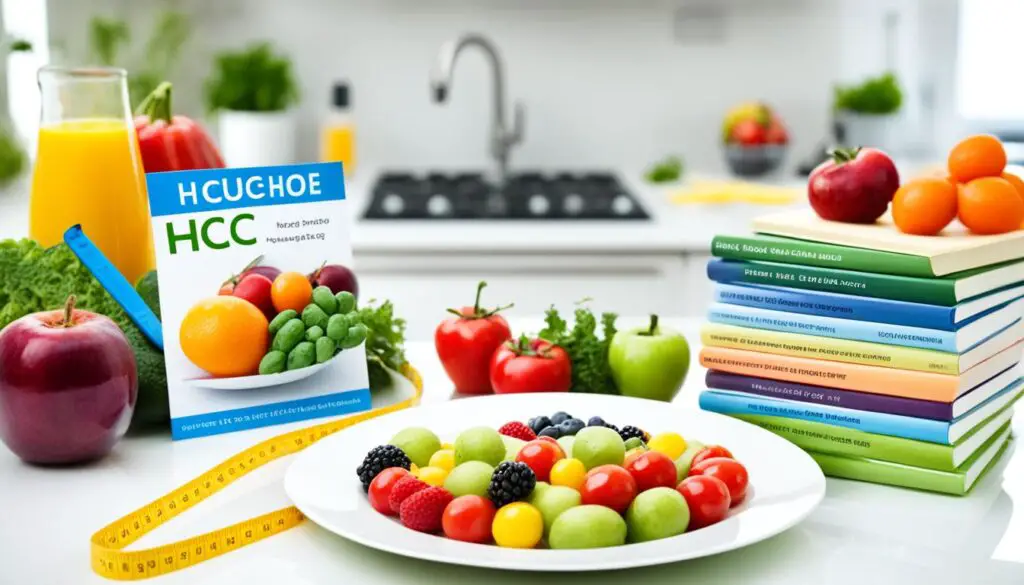
The HCG diet may seem restrictive, but that doesn’t mean you can’t enjoy delicious and satisfying meals while following the protocol. By focusing on lean proteins, vegetables, and portion control, you can create a variety of low-calorie recipes that fit perfectly into the HCG diet plan. Here are some meal ideas to get you started:
Grilled Chicken with Asparagus
Ingredients:
- 4 ounces of chicken breast
- 1 cup of asparagus spears
- Salt and pepper to taste
Instructions:
- Preheat the grill to medium heat.
- Season the chicken breast with salt and pepper.
- Grill the chicken for about 6-8 minutes per side, or until cooked through.
- While the chicken is grilling, steam the asparagus spears until tender.
- Serve the grilled chicken with the steamed asparagus.
Shrimp Stir-Fry with Mixed Vegetables
Ingredients:
- 4 ounces of shrimp
- 1 cup of mixed vegetables (such as bell peppers, broccoli, and onions)
- 1 clove of garlic, minced
- 1 tablespoon of low-sodium soy sauce
- 1 teaspoon of sesame oil
Instructions:
- Heat a non-stick skillet over medium heat.
- Add the minced garlic and shrimp to the skillet, and cook until the shrimp are pink and cooked through.
- Add the mixed vegetables to the skillet and stir-fry for about 3-4 minutes, or until tender.
- In a small bowl, mix together the soy sauce and sesame oil.
- Pour the sauce over the shrimp and vegetables in the skillet, and stir to coat evenly.
- Remove from heat and serve.
Baked White Fish with Steamed Broccoli
Ingredients:
- 4 ounces of white fish (such as cod or tilapia)
- 1 cup of broccoli florets
- Juice of 1 lemon
- Dried herbs of your choice (such as dill or parsley)
- Salt and pepper to taste
Instructions:
- Preheat the oven to 400°F (200°C).
- Place the fish fillet on a baking sheet lined with parchment paper.
- Season the fish with salt, pepper, dried herbs, and lemon juice.
- Bake the fish for about 15-20 minutes, or until cooked through and flaky.
- While the fish is baking, steam the broccoli until tender.
- Serve the baked fish with the steamed broccoli.
These are just a few examples of HCG diet-friendly recipes that you can try. Remember, portion control is key, so make sure to measure your ingredients carefully and stick to the approved foods list. If you need more guidance or recipe ideas, consider consulting with a healthcare professional or nutritionist who specializes in the HCG diet.
HCG Diet Results for Beginners
The HCG diet has gained popularity due to its potential for significant weight loss results in some individuals. While the effectiveness of the HCG hormone in weight loss is still a topic of debate among experts, many people have reported successful outcomes and improved body composition on the HCG diet.
It is important to note that individual results may vary depending on several factors, including adherence to the diet, metabolism, and overall health. The HCG diet requires strict adherence to the recommended foods and portion sizes, as well as following the specific phases of the diet protocol.
Consulting with a healthcare professional before starting the HCG diet is essential to ensure safety and maximize the potential benefits. A healthcare professional can provide personalized guidance, monitor progress, and address any concerns or challenges that may arise.
Tracking your progress throughout the diet is also crucial. Regularly monitoring weight loss, body measurements, and overall well-being can provide valuable insights and help understand the effectiveness of the diet for individual success.
Additionally, it can be beneficial to seek inspiration and motivation from success stories of others who have achieved their weight loss goals on the HCG diet. Hearing about others’ experiences can provide encouragement and reinforce the belief that achieving weight loss results is possible.
Remember, the HCG diet is a restrictive and low-calorie protocol, so it may not be suitable for everyone. It is important to consider other weight loss methods that have a strong scientific foundation and prioritize long-term sustainability and overall health.
| Name | Weight Loss | Body Composition |
|---|---|---|
| Emily | 22 lbs | Reduced body fat percentage |
| Michael | 18 lbs | Increased lean muscle mass |
| Sarah | 15 lbs | Improved overall body shape |
Conclusion
After exploring the HCG diet in detail, it is clear that it can be an enticing option for those seeking rapid weight loss. However, it is crucial to approach this diet with caution and seek guidance from a healthcare professional before embarking on it. The strict calorie restrictions and reliance on the HCG hormone may not be suitable or safe for everyone.
It is important to note that the effectiveness of the HCG hormone in weight loss is not supported by scientific evidence. While some individuals may experience positive results on the HCG diet, outcomes can vary depending on factors such as adherence to the diet and individual metabolism.
Considering the potential risks and lack of scientific evidence, it is recommended to explore other weight loss methods that have a solid foundation in scientific research. Prioritizing long-term sustainability and overall health is crucial when choosing a weight loss approach. It is always best to consult with a healthcare professional who can provide personalized guidance and support for your weight loss journey.
FAQ
What is the HCG Diet Plan for Beginners?
The HCG diet is a weight loss protocol that involves taking the hormone hCG and following a very low-calorie diet. It is important to consult with a healthcare professional before starting.
How does the HCG hormone function in the body?
The HCG hormone is produced during early pregnancy and supports the healthy growth of the uterus and fetus. In the context of the HCG diet, it is believed to promote weight loss by altering metabolism and promoting the use of abnormal fat reserves for energy.
What are the phases of the HCG diet?
The HCG diet consists of three phases: the loading phase, the weight loss phase, and the maintenance phase.
What is the HCG diet meal plan?
The HCG diet meal plan requires adherence to specific foods and portion sizes. It typically includes lean proteins, vegetables, fruits, and limited bread options.
What are some tips for beginners on the HCG diet?
Some tips for beginners on the HCG diet include consulting with a healthcare professional, planning meals, staying hydrated, avoiding temptation, and seeking support from professionals or support groups.
What is Phase 1 of the HCG diet for beginners?
Phase 1 of the HCG diet is known as the loading phase, where you consume high-fat foods for 2 days while taking the HCG hormone.
What is Phase 2 of the HCG diet for beginners?
Phase 2 of the HCG diet is the weight loss phase, where you consume only 500 calories per day while continuing to take the HCG hormone.
What is Phase 3 of the HCG diet for beginners?
Phase 3 of the HCG diet is the maintenance phase, where you gradually increase your food intake but avoid sugar and starch for 3 weeks.
What are the approved foods for beginners on the HCG diet?
Approved foods for beginners on the HCG diet include lean proteins, certain vegetables, fruits, and limited bread options.
What are some HCG diet recipes for beginners?
Some HCG diet recipes for beginners include grilled chicken with asparagus, shrimp stir-fry with mixed vegetables, and baked white fish with steamed broccoli.
What are the HCG diet results for beginners?
The HCG diet has been associated with significant weight loss in some individuals, but it is important to note that results may vary and individual factors can influence outcomes.
What is the conclusion of the HCG diet for beginners?
The HCG diet can be an appealing option for weight loss, but it is important to approach it with caution and consult with a healthcare professional. Other weight loss methods with a strong scientific foundation should also be considered.



